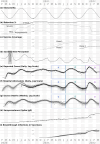Evaluating targeted COVID-19 vaccination strategies with agent-based modeling
- PMID: 38820570
- PMCID: PMC11230632
- DOI: 10.1371/journal.pcbi.1012128
Evaluating targeted COVID-19 vaccination strategies with agent-based modeling
Abstract
We evaluate approaches to vaccine distribution using an agent-based model of human activity and COVID-19 transmission calibrated to detailed trends in cases, hospitalizations, deaths, seroprevalence, and vaccine breakthrough infections in Florida, USA. We compare the incremental effectiveness for four different distribution strategies at four different levels of vaccine supply, starting in late 2020 through early 2022. Our analysis indicates that the best strategy to reduce severe outcomes would be to actively target high disease-risk individuals. This was true in every scenario, although the advantage was greatest for the intermediate vaccine availability assumptions and relatively modest compared to a simple mass vaccination approach under high vaccine availability. Ring vaccination, while generally the most effective strategy for reducing infections, ultimately proved least effective at preventing deaths. We also consider using age group as a practical surrogate measure for actual disease-risk targeting; this approach also outperforms both simple mass distribution and ring vaccination. We find that quantitative effectiveness of a strategy depends on whether effectiveness is assessed after the alpha, delta, or omicron wave. However, these differences in absolute benefit for the strategies do not change the ranking of their performance at preventing severe outcomes across vaccine availability assumptions.
Copyright: This is an open access article, free of all copyright, and may be freely reproduced, distributed, transmitted, modified, built upon, or otherwise used by anyone for any lawful purpose. The work is made available under the Creative Commons CC0 public domain dedication.
Conflict of interest statement
The authors have declared that no competing interests exist.
Figures







Update of
-
Evaluating targeted COVID-19 vaccination strategies with agent-based modeling.medRxiv [Preprint]. 2023 Mar 10:2023.03.09.23285319. doi: 10.1101/2023.03.09.23285319. medRxiv. 2023. Update in: PLoS Comput Biol. 2024 May 31;20(5):e1012128. doi: 10.1371/journal.pcbi.1012128. PMID: 36945423 Free PMC article. Updated. Preprint.
References
-
- Assistant Secretary for Public Affairs (ASPA). type [; 2020]Available from: https://www.hhs.gov/coronavirus/covid-19-vaccines/index.html.
MeSH terms
Substances
Grants and funding
LinkOut - more resources
Full Text Sources
Medical

